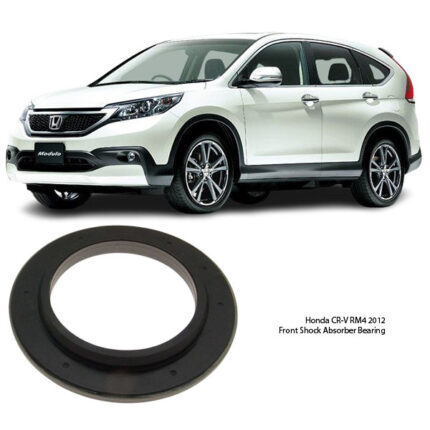-25%
Get Pajero Shogun Front Shock Absorber Bushing
Shock absorber bushings, often referred to simply as shock bushings, are vital components in a vehicle’s suspension system. They play a crucial role in ensuring the effective functioning of the shock absorbers by providing cushioning and reducing vibrations. Here’s a detailed look at shock absorber bushings, their functions, signs of wear, and maintenance:
Function of Shock Absorber Bushings
1. Vibration Isolation
Primary Function: Absorbing and dampening road-induced vibrations to prevent them from being transmitted to the vehicle’s body.
Details:
- Material Properties: Typically made of rubber or polyurethane, which are excellent at absorbing vibrations due to their elastic properties.
- Vibration Damping: As the vehicle encounters bumps and irregularities on the road, the shock absorber and suspension components move. The bushings cushion these movements, reducing the amount of vibration that reaches the chassis and the cabin.
2. Noise Reduction
Primary Function: Minimizing noise generated from suspension movements and road impacts.
Details:
- Noise Isolation: By cushioning the contact points between the shock absorber and the vehicle’s frame, bushings prevent metal-to-metal contact, which can create loud clunking or banging noises.
- Smooth Operation: Properly functioning bushings ensure that the suspension components move smoothly, reducing creaks and squeaks that can occur with worn or dry bushings.
3. Load Distribution
Primary Function: Distributing the loads and stresses encountered by the suspension system evenly across the shock absorbers and other suspension components.
Details:
- Stress Reduction: Bushings help spread out the forces exerted on the suspension system, reducing localized stress points that could lead to premature wear or failure of other suspension parts.
- Enhanced Durability: By evenly distributing loads, bushings help prolong the life of the suspension components, including the shock absorbers, struts, and control arms.
4. Movement Control
Primary Function: Allowing controlled movement and flexibility within the suspension system while maintaining proper alignment and function.
Details:
- Controlled Flexibility: Bushings provide a controlled range of motion for the suspension components, ensuring they can move to absorb shocks without excessive play that could affect vehicle handling.
- Maintaining Geometry: They help maintain the correct alignment and geometry of the suspension system, which is crucial for stable handling and steering precision.
5. Flexibility and Stability
Primary Function: Balancing flexibility and stability to adapt to various road conditions while maintaining control and safety.
Details:
- Adapting to Terrain: Bushings allow the suspension to flex and adapt to different road surfaces, providing a balance between a comfortable ride and the ability to handle rough terrain.
- Stabilizing Suspension: They stabilize the suspension components, preventing excessive movement that could lead to instability or a lack of control.
6. Reducing Wear and Tear
Primary Function: Protecting other suspension components from excessive wear by providing cushioning and reducing friction.
Details:
- Friction Reduction: By isolating components from direct contact, bushings reduce friction and wear on parts like the shock absorber rods, mounts, and the vehicle frame.
- Extended Component Life: This protective function helps extend the lifespan of various suspension parts, reducing the need for frequent repairs or replacements.
7. Enhancing Ride Comfort
Primary Function: Contributing to a smoother and more comfortable ride by absorbing shocks and vibrations.
Details:
-
- Smooth Ride Quality: Effective bushings absorb small bumps and vibrations, ensuring that the ride remains smooth and comfortable for passengers.
- Minimizing Harshness: They minimize the harshness of road impacts, preventing jarring movements that can be felt within the cabin.
Types of Shock Absorber Bushings
- Rubber Bushings: These are the most common type, known for their flexibility and ability to absorb vibrations. They offer a softer ride but can wear out faster under harsh conditions.
- Polyurethane Bushings: These are more durable and provide better performance under high-stress conditions. They are firmer than rubber bushings and offer improved handling but can transmit more vibrations and noise.
Signs of Worn Shock Absorber Bushings
- Unusual Noises:
- Clunking or Banging: Metal-to-metal contact due to worn bushings can cause clunking or banging noises, especially when driving over bumps or rough surfaces.
- Squeaking: This noise can indicate that the bushings are dried out or have started to crack and deteriorate.
- Poor Handling:
- Reduced Stability: Worn bushings can affect the vehicle’s stability, causing it to feel loose or less responsive, especially during cornering or sudden maneuvers.
- Increased Body Roll: The vehicle may exhibit more body roll during turns due to reduced effectiveness of the suspension system.
- Vibrations:
- Steering Wheel Vibrations: Increased vibrations felt through the steering wheel can be a sign of worn bushings, as they are no longer effectively dampening the road impacts.
- Vehicle Vibrations: Overall increased vibrations throughout the vehicle, particularly when driving over uneven surfaces.
- Misalignment:
- Steering Pull: The vehicle may pull to one side if the bushings are excessively worn, leading to misalignment of the suspension components.
- Uneven Tire Wear: Worn bushings can cause improper alignment and lead to uneven tire wear patterns, reducing tire life.
- Visual Inspection:
- Cracks or Tears: Visible cracks, tears, or other damage in the rubber or polyurethane material.
- Deformation: Noticeable deformation or flattening of the bushings, indicating they are no longer providing effective cushioning.
Maintenance and Replacement
- Regular Inspection: Periodically inspect the shock absorber bushings for signs of wear or damage. This is especially important if you frequently drive on rough roads or under harsh conditions.
- Lubrication: Some bushings may require periodic lubrication to maintain their flexibility and prevent drying out, though many modern bushings are designed to be maintenance-free.
- Replacement:
- Tools and Safety: Replacing bushings typically involves raising the vehicle, removing the shock absorbers, and pressing out the old bushings. Specialized tools and safety precautions are necessary.
- Professional Help: Due to the complexity and safety considerations, it is often recommended to have bushings replaced by a professional mechanic.
Follow us on Facebook for more parts.





